Complete Solutions to (Competition)Multiple choice of chapter RAY OPTICS of Class 11 book with complete answers and questions
| Class 11 | PHYSICS |
| Chapter | RAY OPTICS |
| PRADEEP | (Competition)Multiple choice |
| Number Of Questions | 89 |
| Academic Year | 2023-24 |
A source of light lies on the angle bisector of two plane mirrors inclined at angle `theta`. The value of `theta`, so that the light reflected from one mirror does not reach the other mirror will be.
View SolutionA ray of light travelling in the direction `(1)/(2)(hat(i)+sqrt(3)hat(j))` is incident on a plane mirror. After reflection, it travels along the direction `(1)/(2)(hat(i)-sqrt(3)hat(j))` . The anglel of incidence is
View SolutionThe ratio of the speed of an object to the speed of its real image of magnification `m` in the case of a convex mirror is.
View SolutionThe graph in Fig. shows plot of variation of `v` with change in `u` for a concave mirror. Points plotted above the point `P` on the curve are for values of `v` :
 .
.
View SolutionA beam of light from a source `L` is incident normally on a plane mirrorr fixed at a certain distance `x` from the source. The beam is reflected back as a spot on a scale placed just above the source `L`. When the mirrorr is rotated through a small angle `theta`, the spot of the light is found to move through a distance `y` on the scale. The angle `theta` is given by `:`
View SolutionIn a concave mirror, an object is placed at a distance `d_1` from the focus and the real image is formed aat a distance `d_2` from the focus. Then the focal length of the mirror is :
View SolutionA short linear object of length b lies along the axis of a concave mirror of focal length f at a distanee u from the pole of the mirror. The size of the image is approximately equal to
View SolutionA car is fitted with a convex side-view mirror of focal length 20 cm. A second car 2.8m behind the first car is overtaking the first car at a relative speed of 15 `m/s`. The speed of the image of the second car as seen in the mrror of the first one is:
View SolutionA rod of length 10 cm lies along the principal axis of a concave mirror of focal length 10 cm in such a way that the end closer to the pole is 20 cm away from it. Find the length of the image.
View SolutionConsider a concave mirror and a convex lens (refractive index 1.5) of focal length `10 cm` each separated by a distance of `50 cm` in air (refractive index = 1) as shown in the Fig. An object is placed at a distance of `15 cm` from the mirror. Its erect image formed by this combination has magnification `M_1`. When this set up is kept in a medium of refractive index `7//6`, the magnification becomes `M_2`. The magnitude `((M_2)/(M_1))` is :
 .
.
View SolutionTwo identical glass rods `S_(1)` and `S_(2)` (refractive index=1.5) have one convex end of radius of curvature 10 cm. They are placed with the curved surfaces at a distance d as shown in the figure, with their axes (shown by the dashed line) aligned. When a point source of light P is placed inside rod `S_(1)` on its axis at a distance of 50 cm from the curved face, the light rays emenating from it are found to be parallel to the axis inside `S_(2)`. The distance d is
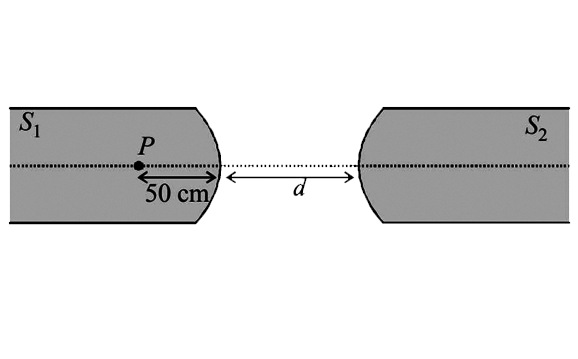
View SolutionTwo identical thin planoconvex glass lenses (refractive index `1.5)` each having radius of curvature of `20cm` are placed with their convex surfaces in contact at the centre. The intervening space is filled with oil of refractive index `1.7`. The focal length of the combination is
View SolutionA diverging lens with magnitude of focal length `25 cm` is placed at a distance of `15 cm` from a converging lens of magnitude of focal length `20 cm`. A beam of parallel light falls on the diverging lens. The final image formed is.
View SolutionAn observer can see through a pin-hole the top end of a thin rod of height h, placed as shown in the figure. The beaker height is 3h and its radius h. When the beaker is filled with a liquid up to a height 2h, he can see the lower end of the rod. Then the refractive index of the liquid is
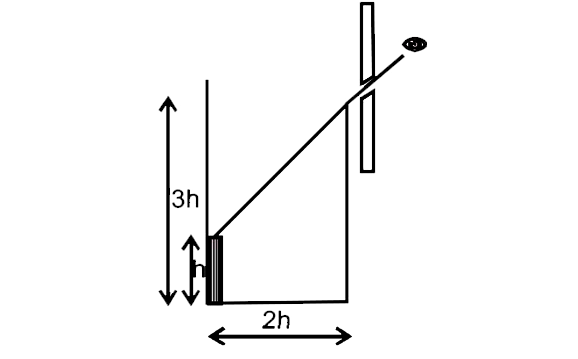
View SolutionFor a given incident ray as shown in Fig., the condition of total internal reflection of ray will be satisfied if the refractive index of the block will be.
 .
.
View SolutionConsidering normal incidence of ray, the equivalent refractive index of combination of two slabs shown in Fig. is.
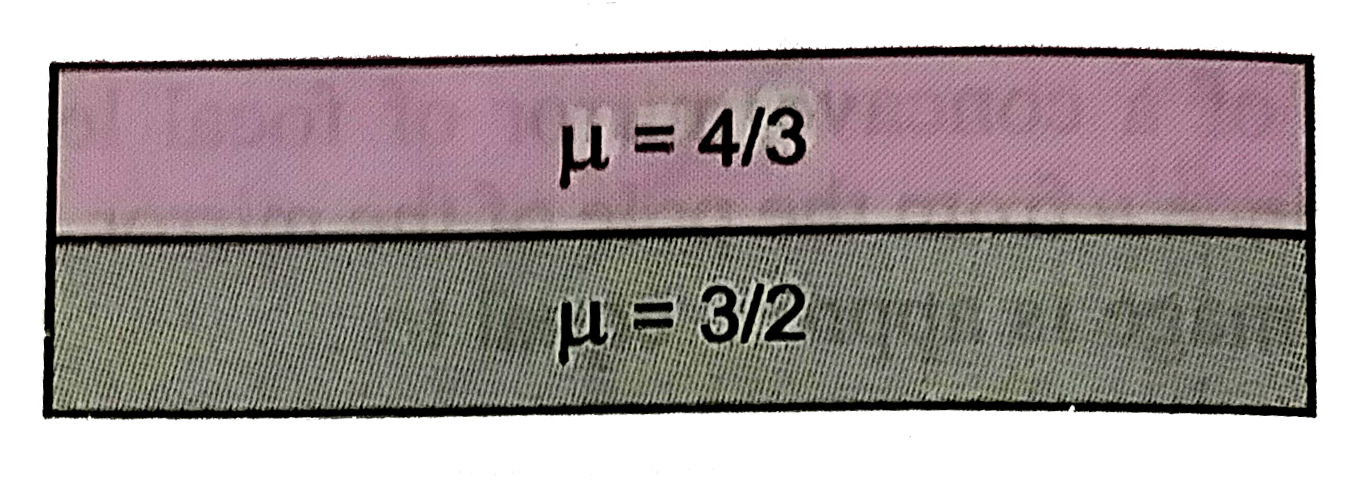 .
.
View SolutionThe graph in Fig. shows how the inverse of magnification `1//m` produced by a convex thin lens varies with object distance `u`. What was the focal length of the lens used ?
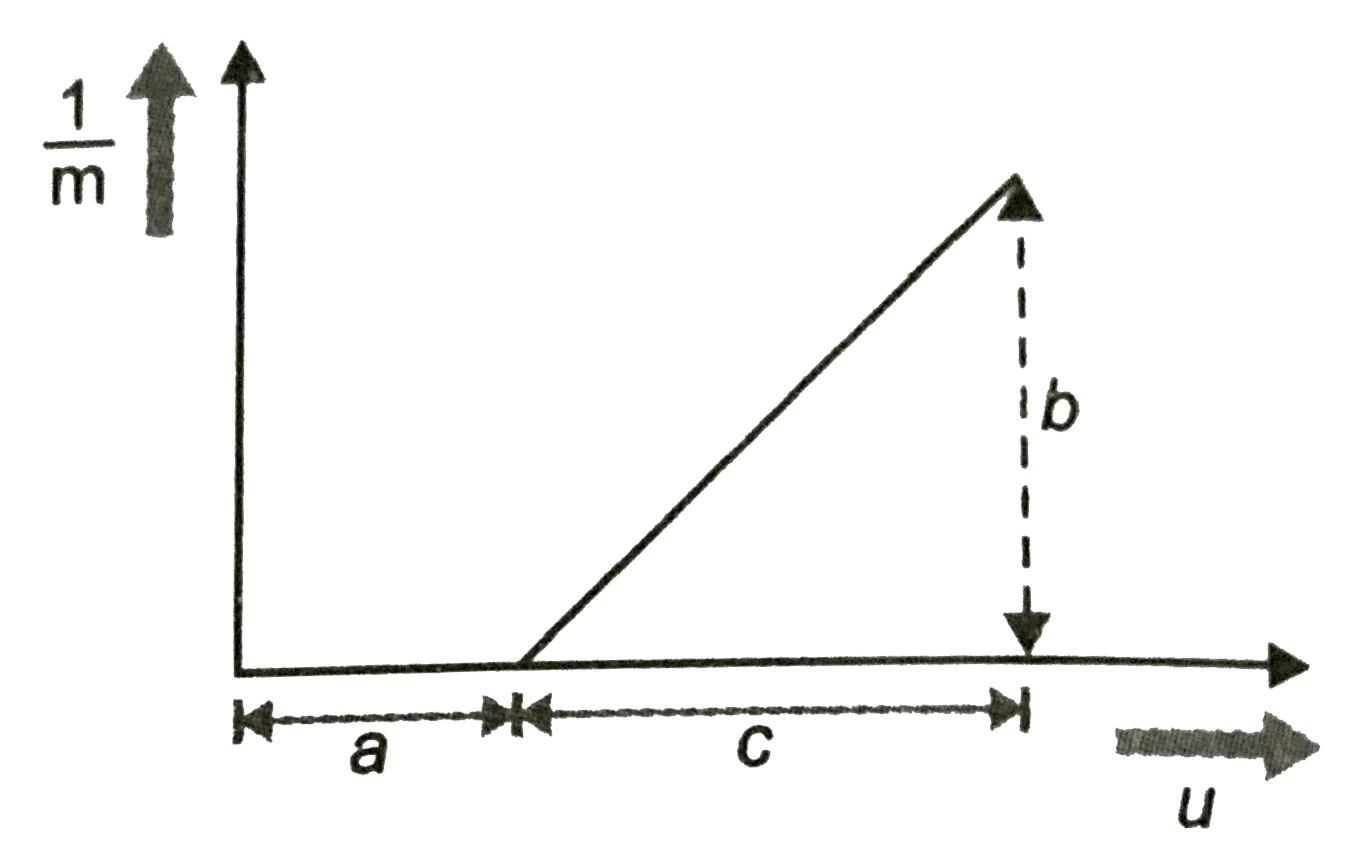 .
.
View SolutionConsider the ray diagram for the refraction given Fig. The maximum value of angle `theta` for which the light suffers total internal reflection at the vertical surface, is.
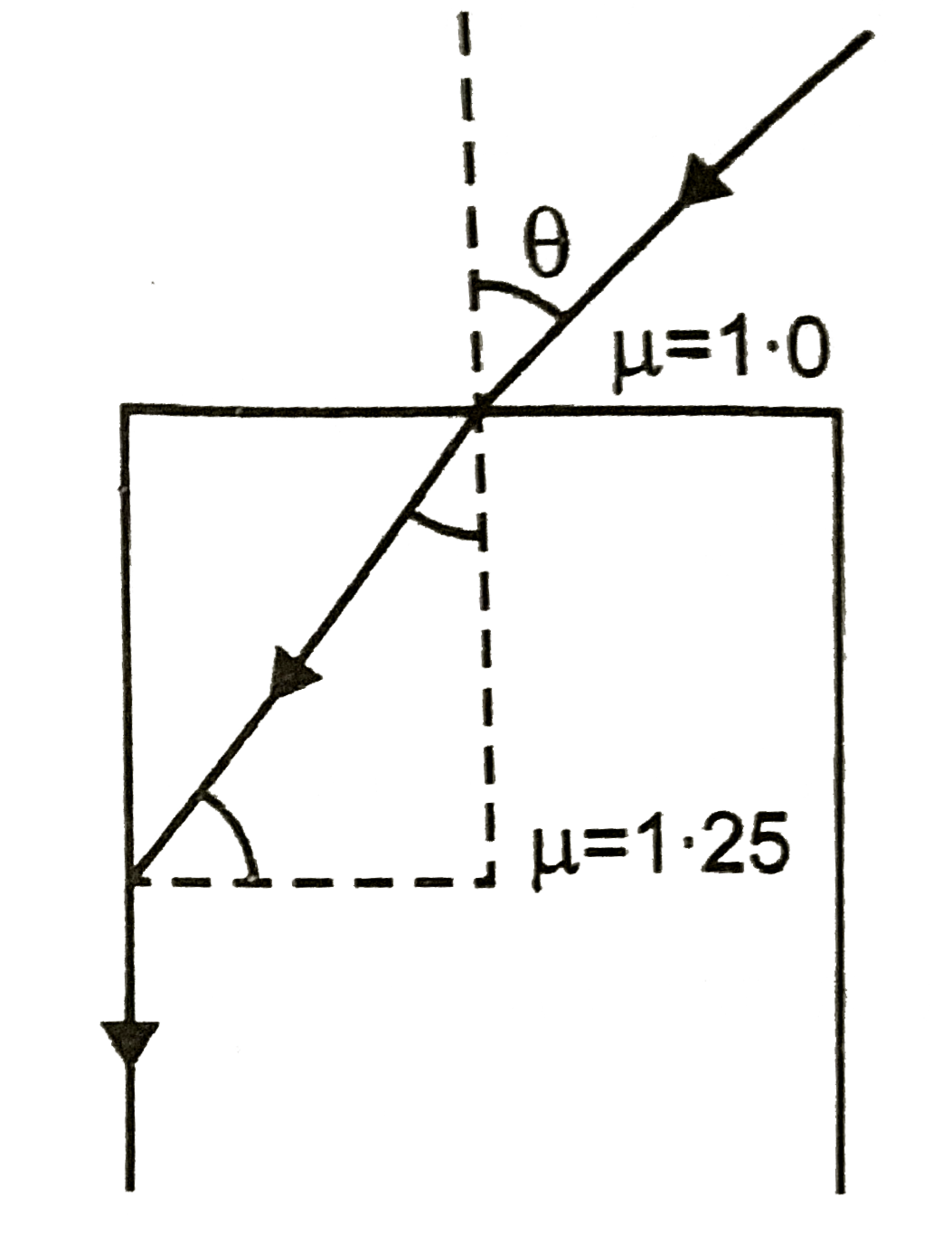 .
.
View SolutionA luminous object is placed at a distance of `30 cm` from the convex lens of focal length `20 cm`. On the other side of the lens, at what distance from the lens a convex mirror of radius of curvature `10 cm` be placed in order to have an upright image of the object coincident with it ?
View SolutionFour combinations of two thin lenses are given in List `I`. The radius of curvature of all curved surfaces is `r` and the refractive index of all the lenses is `1.5` Match lens combinations in List `I` with their focal length in List `II` and select the correct answer using the code given below the lists.
(A) `(p) 2 r`
(B) `(q) ( r)/(2)`
( C) `(r) - r`
(D) `(s) r`.
Code :
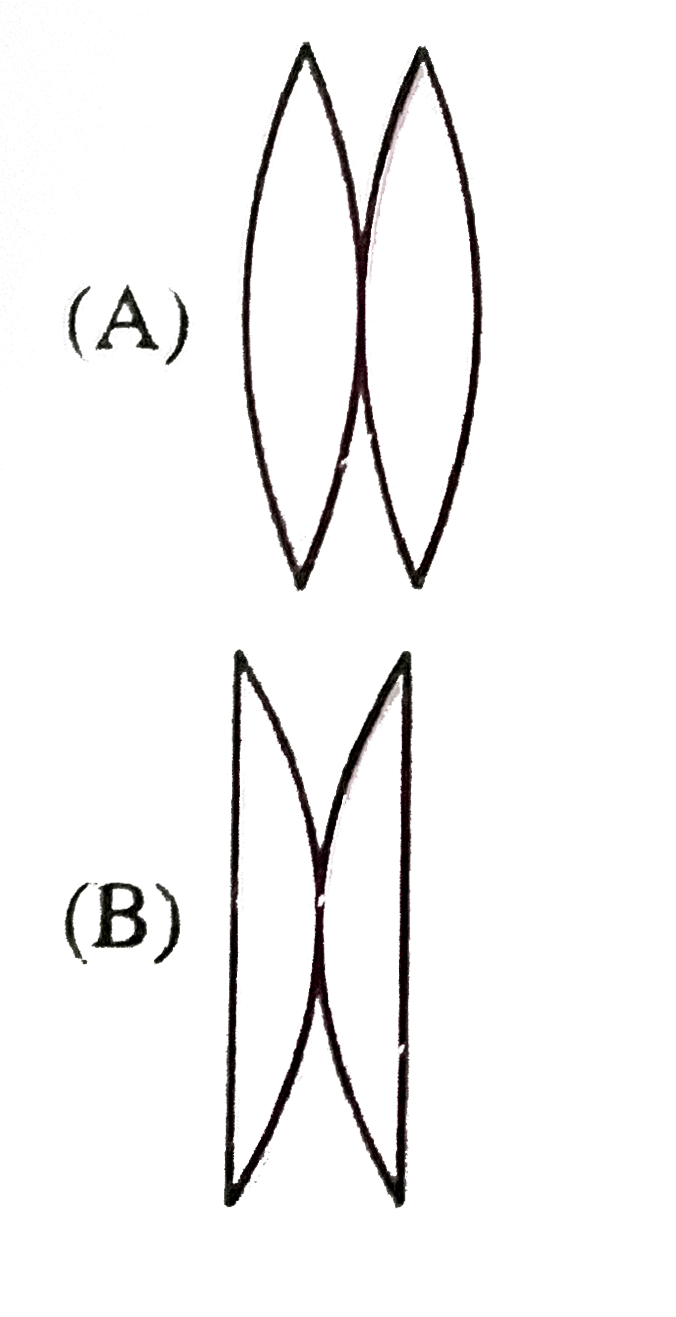
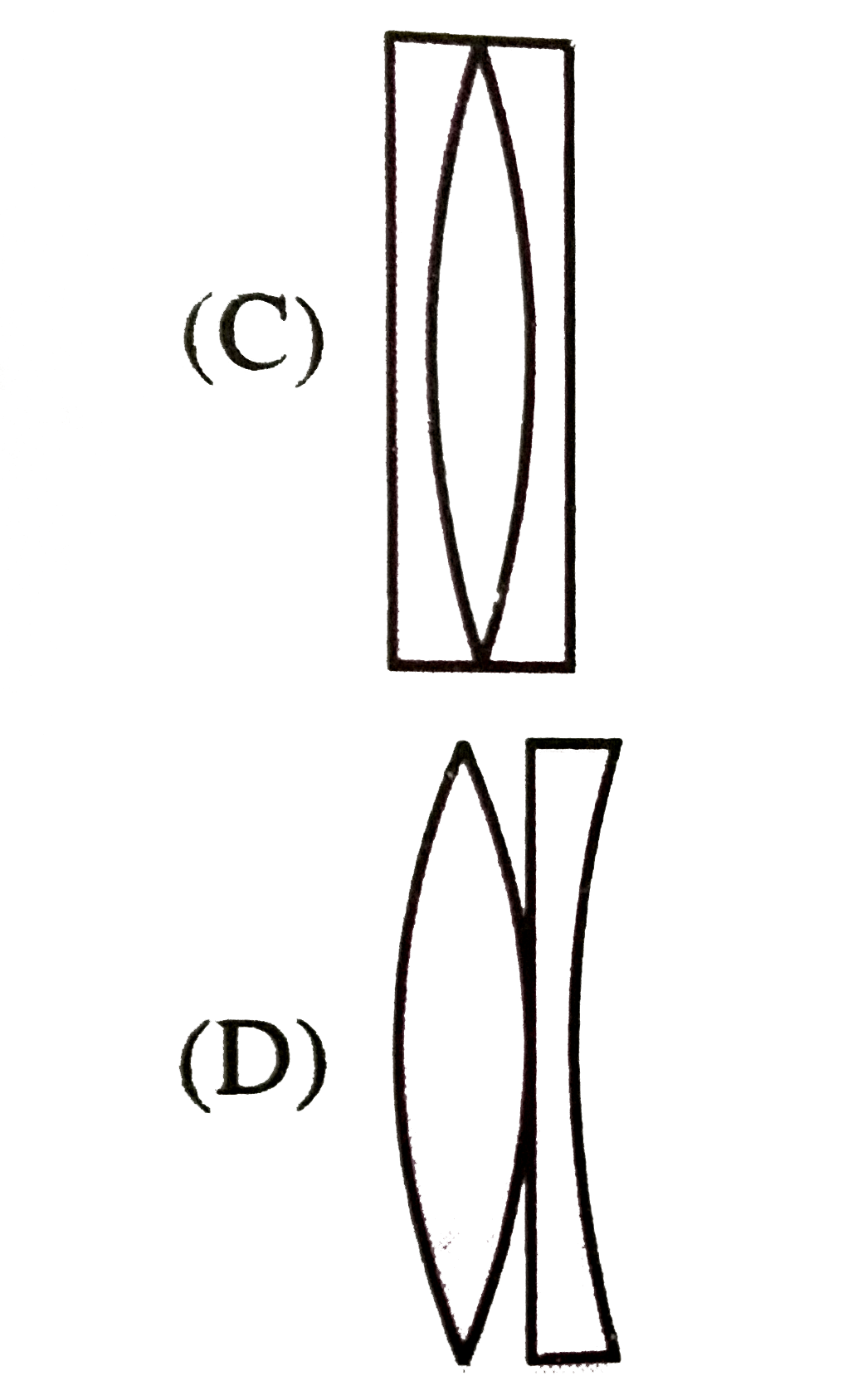
View SolutionThe effective focal length of the lens combination shown in Fig. is `-60 cm`. The radii of curvature of the curved surfaces of the plano-convex lenses are `12 cm` each and refractive index of the material of the lens is `1.5`. The refractive index of the liquid is :
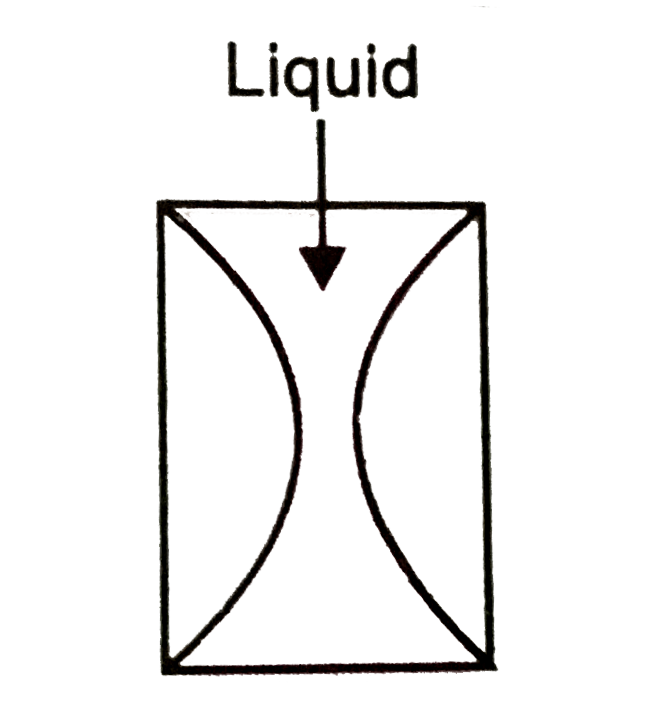 .
.
View SolutionA ray of light falls on the surface of a spherical glass paper weight making an angle `alpha` with the normal and is refracted in the medium at an angle `beta`. The angle of deviation of the emergent ray from the direction of the incident ray is :
View SolutionLight incident on a surface separating two media is partly reflected and party refracted as shown in Fig. Then :
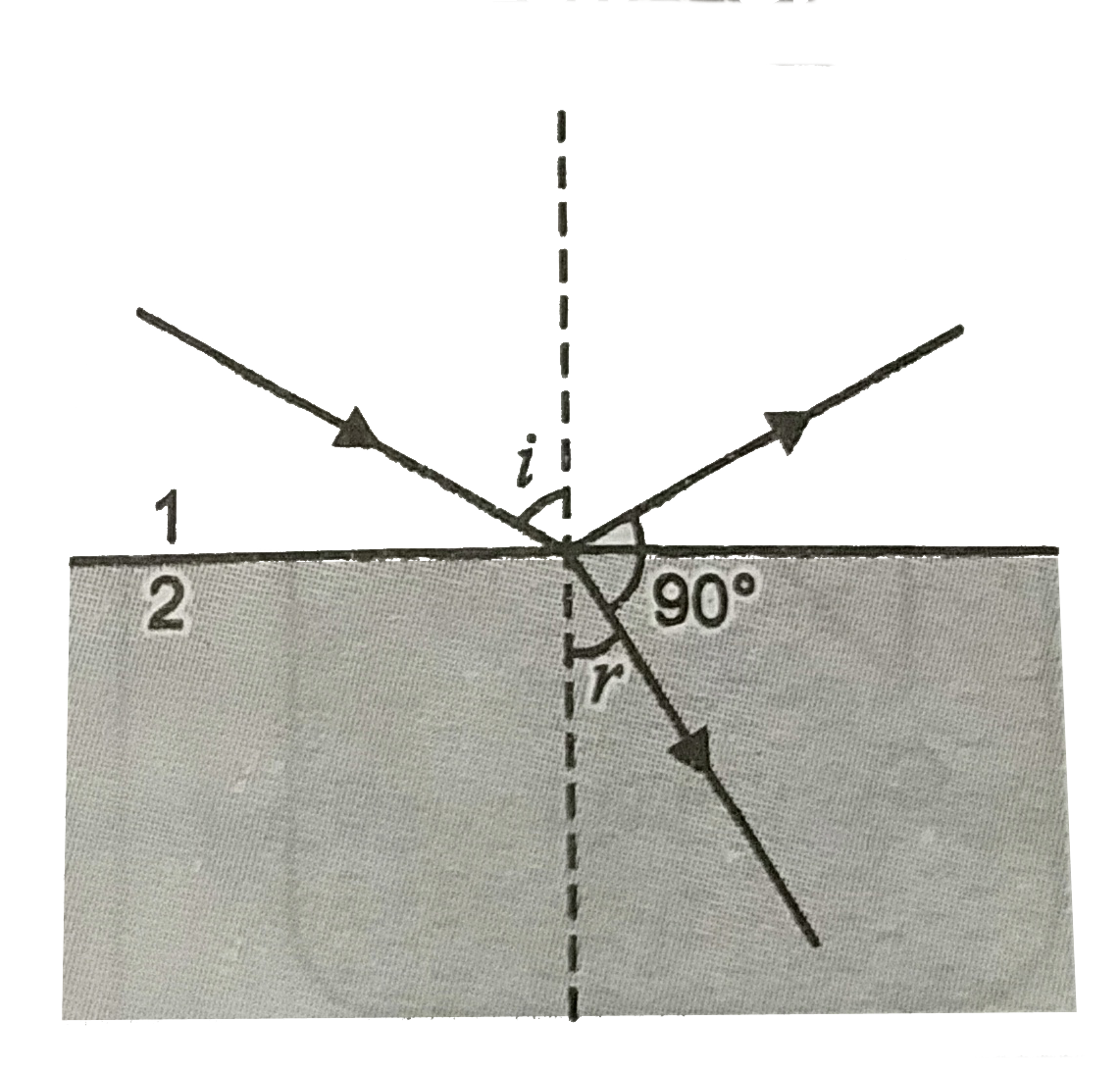 .
.
View SolutionA slab of transparent material is made as shown in Fig. Monochromatic parallel beams of light are normally incident on the slab. The thickness of `C` is twice the thickness of `B`. If the number of waves in A = number of waves in combination of `B and C`, then the refractive index of `B` is :
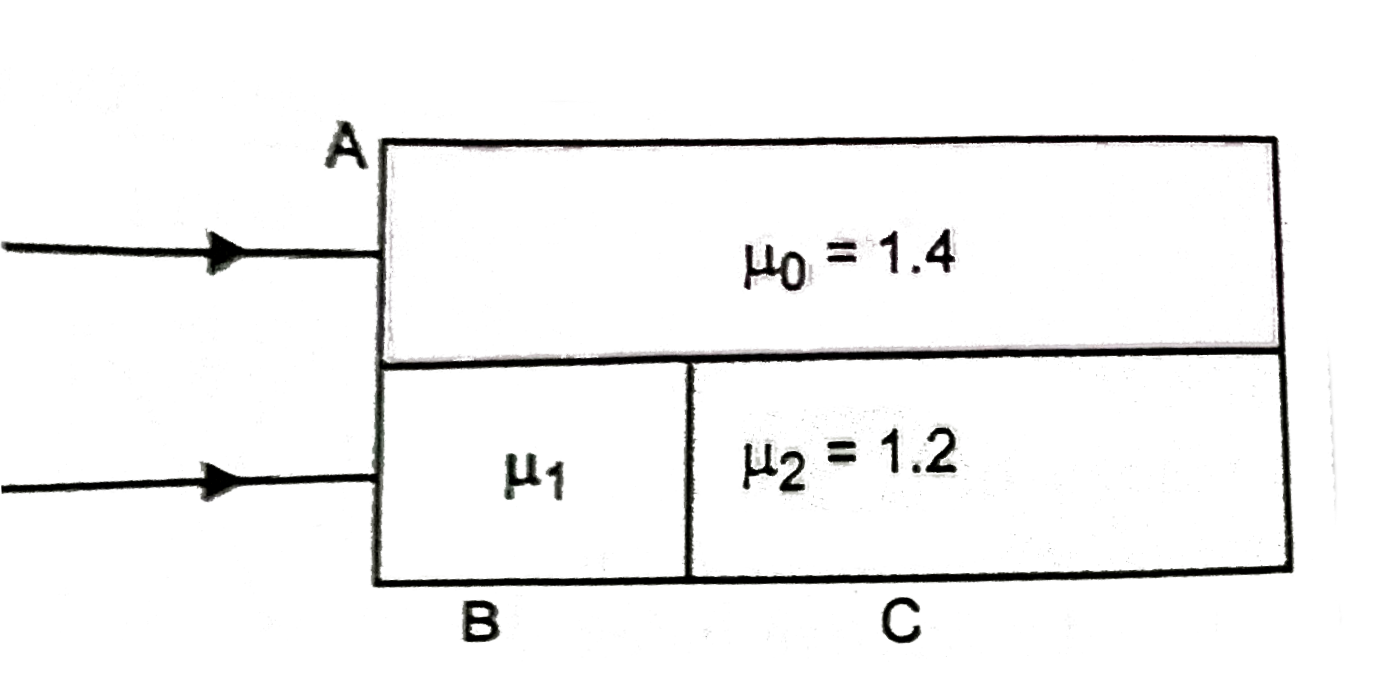 .
.
View SolutionThe focal length of a thin lens in vacuum is `f`. If the material of the lens has `mu = 3//2`, its focal length when immersed in water of refractive index `4//3` will be.
View SolutionA glass prism of refractive index `1.5` is immersed in water (refractive index 4/3). A light beam incident normally on the face `AB` is totally reflected to reach the face `BC`, Fig. if :
 .
.
View SolutionThe radius of curvature of curved surface of a thin plano-convex lens is `10 cm` and the refractive index is `1.5`. If the plano surface is silvered, then the focal length will be.
View SolutionThe refracting angle of a prism is `A`, the refractive index of the material of the prism is `cot((A)/(2))`. The angle of minimum deviation is :
View SolutionA beam of light consisting of red, green and blue colours is incident on right angled prism. The refractive indices of the material of the prism for the above red, green and blue wavelengths are `1.39,1.44 and 1.47` respectively. The prism will.
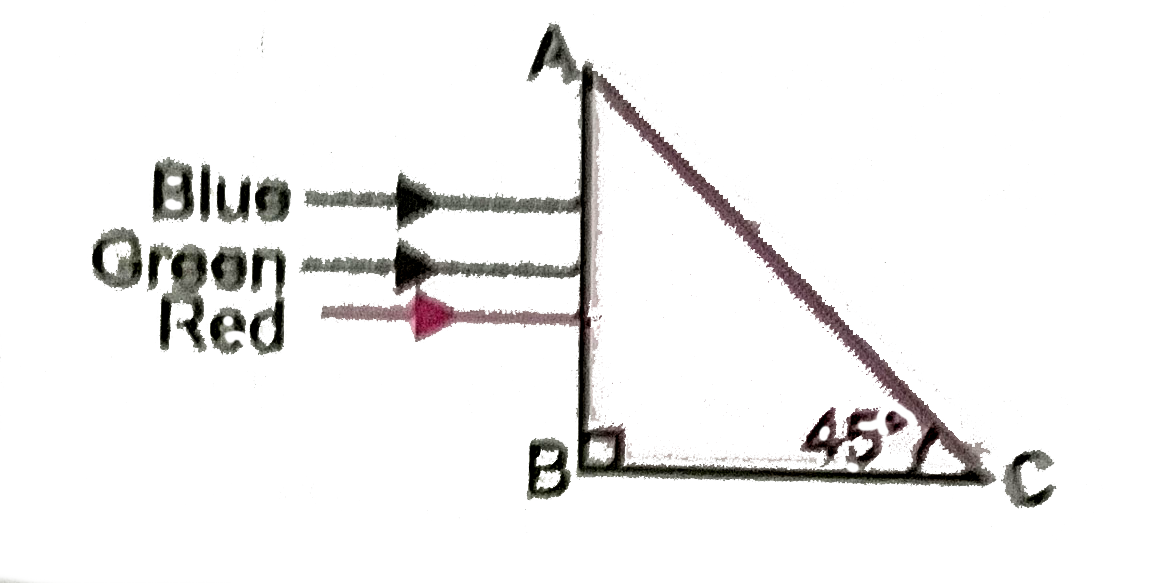 .
.
View SolutionA plano convex lens has focal length `f = 20 cm`. If its plane surface is silvered, then new focal length will be
View SolutionIn an optics experiment, with the position of the object fixed, a student varies the position of a convex lens and for each position, the screen is adjustment to get a clear image of the object. A graph between the object distance `u` and image distance `v` from the lens, is plotted using the same scale for the axes. A straight line passing through origin and making an angle of `45^@` with the x-axis meets the experimental curve at `P`. The coordinate of `P` will be.
View SolutionThe focal length of a thin biconvex lens is `20 cm`. When an object is moved from a distance of `25 cm` in front of it to `50 cm`, the magni-fication of its image changes from `m_(25) to m_(50)`. The ratio `(m_(25))/(m_(50))` is.
View SolutionA thin convex lens made from crown glass `(mu=(3)/(2))` has focal length f. When it is measured in two different liquids having refractive indices `(4)/(3)` and `(5)/(3)`, it has the focal lengths `f_1` and `f_2` respectively . The correct relation between the focal lengths is ,
View SolutionIn Fig., there are two convex lenses `L_1 and L_2` having focal lengths `F_1` and `F_2` respectively. The distance between `L_1` and `L_2` will be :
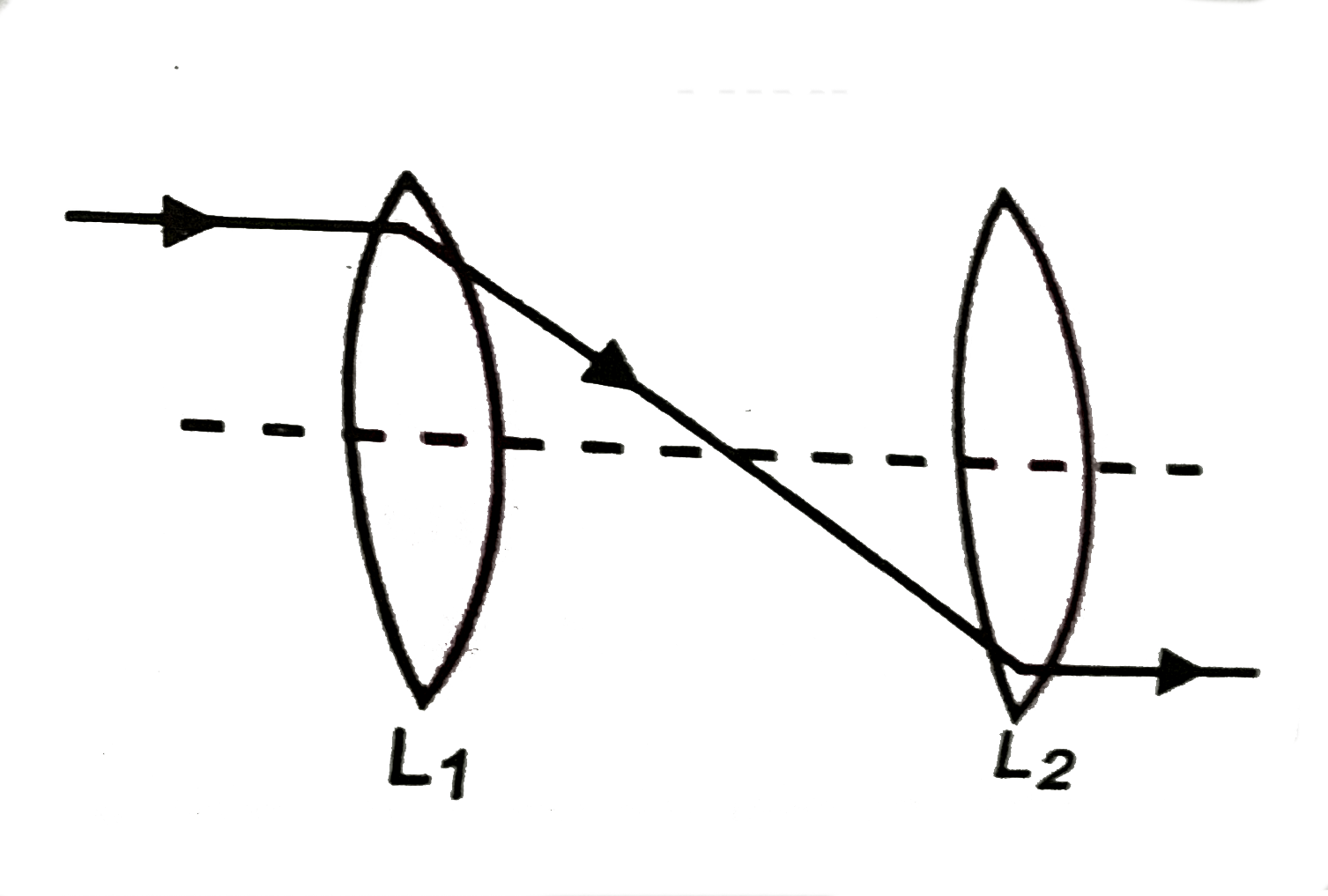 .
.
View SolutionA point source S is placed at the bottom of a tranparent block of height 10mm and refractive index 2.72. It is immersed in a lower refractive index liquid as shown in the figure. It is found that the light emerging from the block to the liquid forms a circular bright spot of diameter 11.54 mm on the top of the block. The refractive index of the liquid is `
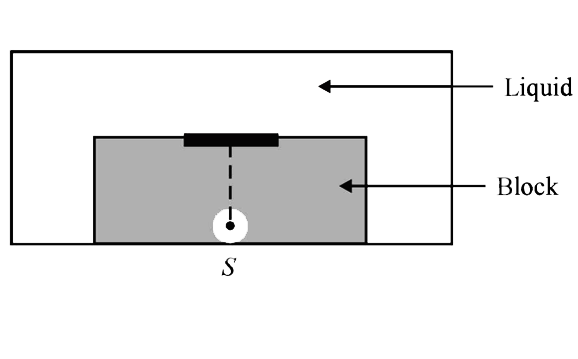
View SolutionA ray of light travelling in a transparant medium falls on a surface separating the medium from air at an angle of incidence of `45degree`. The ray undergoes total internal reflection. If n is the refractive in index of the medium with respect to air, select the possible value (s) of n from the following:
View SolutionA lens haivng focal length and aperture of diameter d forms an image of intensity `I`. Aperture of diameter `d/2` in central region of lens is covered by a black paper. Focal length of lens and intensity of image now will be respectively.
View SolutionThe speed of light in media `M_1` and `M_2` are `1.5 xx 10^8 m//s and 2.0 xx 10^8 m//s` respectively. A ray of light enters from medium `M_1` to `M_2` at an incidence angle `i`. If the ray suffers total internal reflection, the value of `i` is.
View SolutionThe angle of incidence for a ray of light at a refracting surface of a prism is `45^(@)`. The angle of prism is `60^(@)`. If the ray suffers minimum deviation through the prism, the angle of minimum deviation and refractive index of the material of the prism respectively, are `:`
View SolutionIn an experiment for determination of refractive index of glass of a prism by `i-delta`, plot it was found thata ray incident at angle `35^circ`, suffers a deviation of `40^circ` and that it emerges at angle `79^circ`. In that case which of the following is closest to the maximum possible value of the refractive index?
View SolutionA parallel beam of light is incident from air at an angle `alpha` on the side of right angled triangular prism of refractive index `mu = sqrt(2)`. Light undergoes total internal reflection in the prism at the face `PR` when `alpha` has a minimum value of `45^@`. The angle `theta` of the prism is.
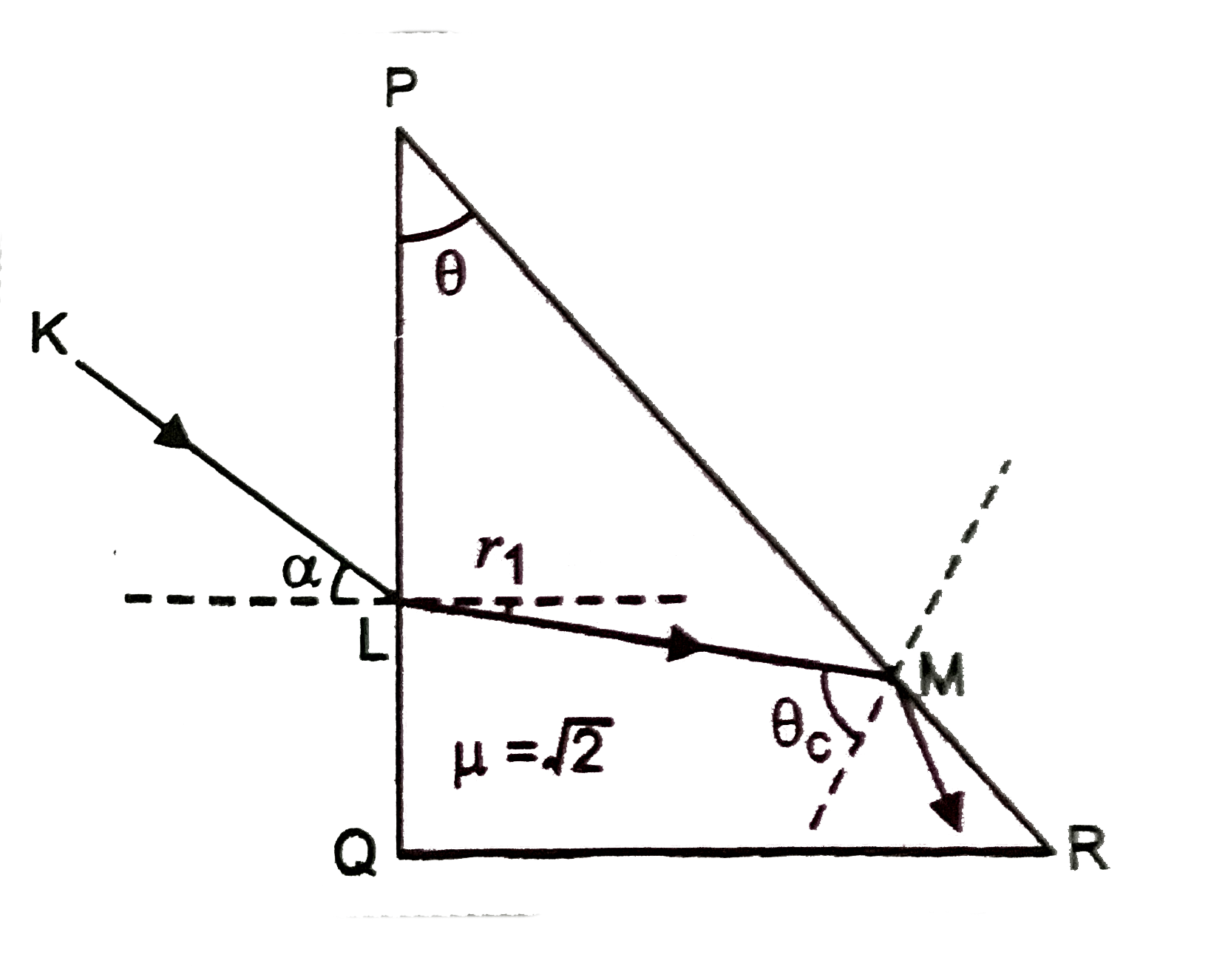 .
.
View SolutionA light ray travelling in glass medium is incident of glass- air interface at an angle of incidence `theta`. The reflected `(R )` and transmitted (T) intensities, both as function of `theta`, are plotted The correct sketch is
View SolutionWater (with refractive index = 4/3) in a tank is `18 cm` deep. Oil of refraction index `7//4` lies on water making a convex surface of radius of curvature `R = 6 cm` as shown in Fig. Consider oil to act as a thin lens. An object `S` is placed `24 cm` above water surface. The location of its image is at `x cm` above the bottom of the tank. Then `x` is.
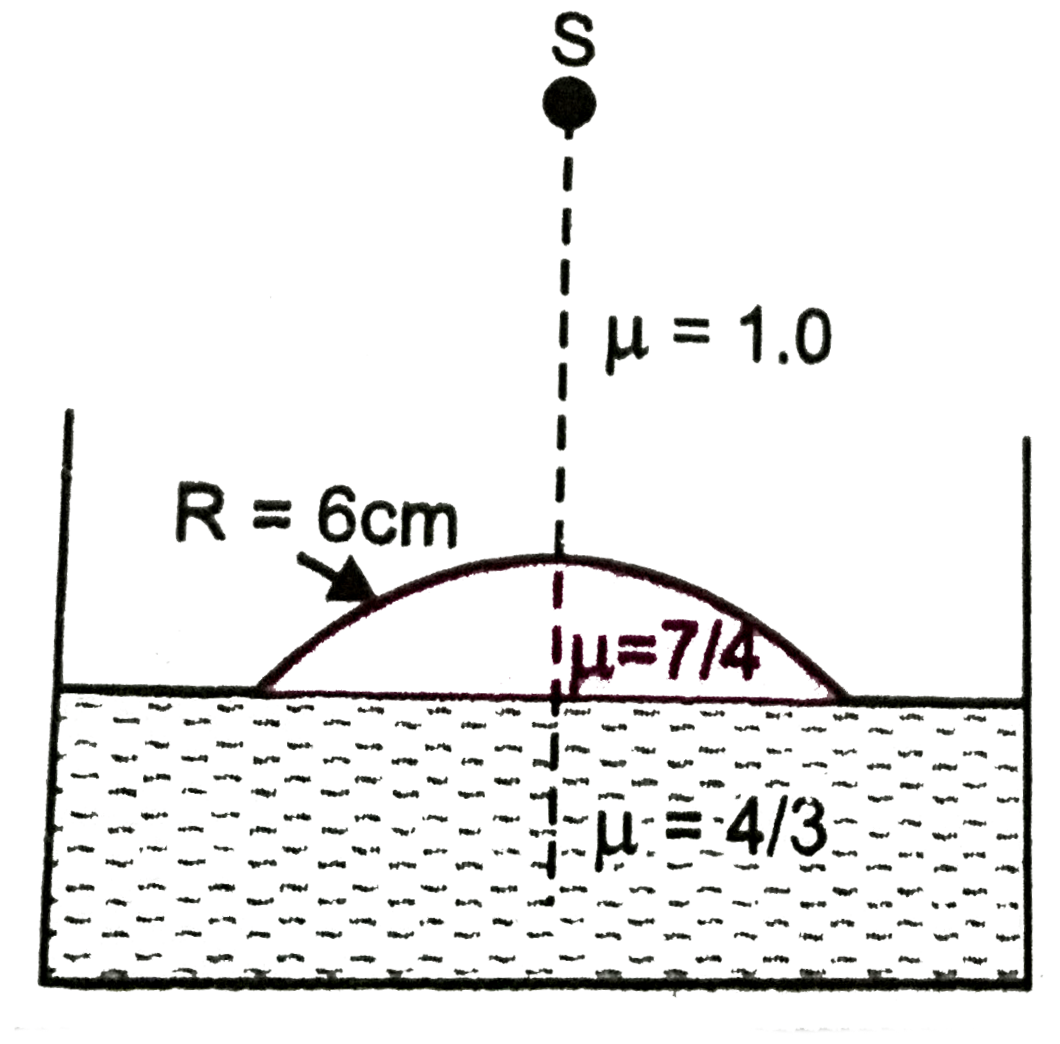 .
.
View SolutionA biconvex lens has a radius of curvature of magnitude `20cm`. Which one of the following options describes best the image formed of an object of height `2cm` place `30 cm` from the lens ?
View SolutionA converging beam of rays in incident on a diverging lens. Having passed through the lens the rays intersect at a point `15 cm` from the lens. If the lens is removed, the point where the rays meet, move `5 cm` closer to the mounting that holds the lens. Find the focal length of the lens.
View SolutionA bi-convex lens is formed with two thin plano-convex lenses as shown in the figure. Refractive index n of th efirst lens is 1.5 and that of the second lens if 1.2 Both the curved surfaces are of the same radius of curvature `R=14cm. ` For this bi-convex lens, for an object distance of 40cm, the image distance will be
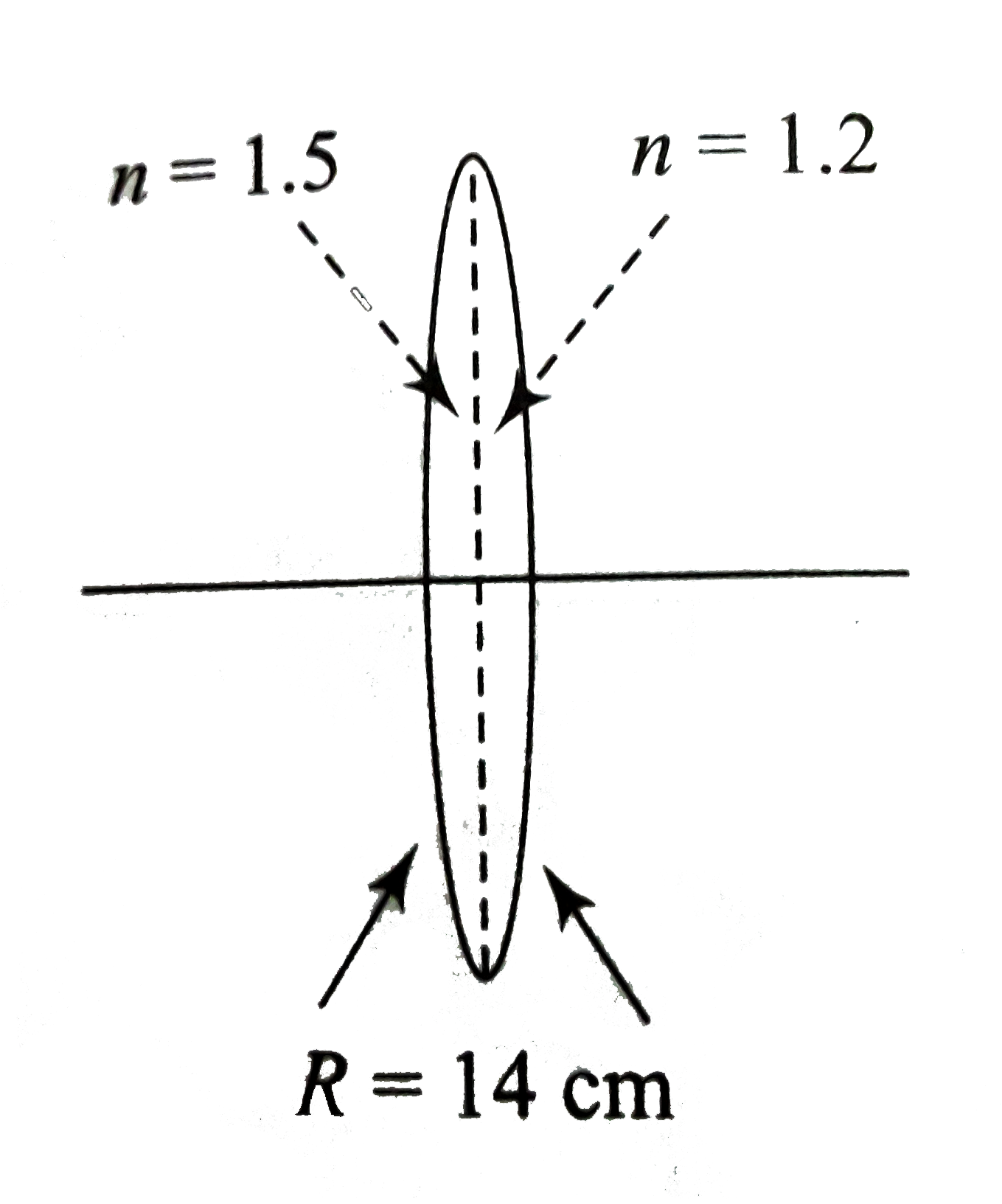
View SolutionAn object 2.4 m in front of a lens forms a sharp image on a film 12 cm behind the lens. A glass plate 1 cm thick, of refractive index 1.50 is interposed between lens and film with its plane faces parallel to film. At what distance (from lens) should object shifted to be in sharp focus of film?
View SolutionA concave mirrorr of focal length `f_(1)` is placed at a distance of `d` from a convex lens of focal length `f_(2)`. A beam of light coming from infinity and falling on this convex lens-concave mirrorr combination returns to infinity. The distance `d` must equal.
View SolutionA plano-convex lens fits exactly into a plano-concave lens. Their plane surfaces are parallel to each other. If the lenses are made of different material of refractive indices `mu_(1)` and `mu_(2)` and R is the radius of curvature of the curved surface of the lenses, then focal length of the combination is
View SolutionThe diameter of a plano convex lens is `6 cm` and thickness at the centre is `3 mm`. If the speed of light in the material of the lens is `2 xx 10^8 m//s`, what is the focal length of the lens ?
View SolutionMonochromatic light is incident on a glass prism of angle A. If the refractive index of the material of the prism is `mu`, a ray, incident at an angle `theta`, on the face AB would get transmitted through the face AC of the prism provided:

View SolutionA monochromatic beam of light is incident at `60^@` on one face of an equilateral prism of refractive inder `n` and emerges from the opposite face making an angle `theta` with the normal. For `n = sqrt(3)`, the value of `theta` is `60^@ and (d theta)/(dn) = m`. The value of `m` is.
View SolutionThe refracting angle of a prism is `A`, the refractive index of the material of the prism is `cot((A)/(2))`. The angle of minimum deviation is :
View SolutionA beam of light consisting of red, green and blue colours is incident on right angled prism. The refractive indices of the material of the prism for the above red, green and blue wavelengths are `1.39,1.44 and 1.47` respectively. The prism will.
 .
.
View SolutionAngle of prism is `A` and its one surface is silvered. Light rays falling at an angle of incidence `2 A` on first surface return back through the same path after suffering reflection at second silvered surface. Refraction index of the material of prism is
View SolutionA green light is incident from the water to the air - water interface at the critical angle `(theta)`. Select the correct statement.
View SolutionWhich one of the following spherical lenses does not exhibit dispersion? The radii of curvature of the surfaces of the lenses are as given in the diagrams. `
View SolutionA thin prism having refracting angle `10^(@)` is made of glass of refracting index `1.42`. This prism is combined with another thin prism of glass of refractive index `1.7`. This combination produces dispersion without deviation. The refracting angle of second prism should be `:`
View SolutionA thin prism of angle `15^(@)` made of glass of refractive index `mu_(1)=1.5` is combined with another prism of glass of refractive index `mu_(2)=1.75`. The combination of the prism produces dispersion without deviation. The angle of the second prism should be
View SolutionA ray of light is incident at small angle I on the surface of prism of small angle A and emerges normally from the oppsite surface. If the refractive index of the material of the prism is mu, the angle of incidence is nearly equal to
View SolutionFor the angle of minimum deviation of a prism to be equal to its refracting angle, the prism must be made of a material whose refractive index
View SolutionMagnification of a compound microscope is 30. Focal length of eye`-` piece is `5 cm` and the image is formed at a distance of distinct vision of `25 cm`. The magnificatio of the objective lens is
View SolutionThe ratio of resolving powers of an optical microscope for two wavelengths `lambda_1=4000Å` and `lambda_2=6000Å` is
View SolutionAn astronaut is looking down on earth's surface from a space shuttle at an altitude of `400 km. ` Assuming that the astronaut's pupil diameter is `5 mm` and the wavelength of visible light is `500 nm. ` The astronaut will be able to resolve linear object of the size of about .
View SolutionA telescope has an objective lens of `10cm` diameter and is situated at a distance of one kilometre from two objects. The minimum distance between these two objects, which can be resolved by the telescope, when the mean wavelength of light is `5000 Å`, of the order of
View SolutionIf the focal length of the objective lens is increased then
View SolutionA microscope is focused on a mark on a piece of paper and then a slab of glass of thickness `3cm` and refractive index `1.5` is placed over the mark. How should the microscope be moved to get the mark in focus again ?
View SolutionA boy is trying to start a fire by focusing sunlight on a piece of paper using an equiconvex lens of focal length `10cm`. The diameter of the sun is `1.39xx10^(9)m` and its mean distance from the earth is `1.5xx10^(11)m`. What is the diameter of the sun's image on the paper ?
View SolutionThe magnifying power of a telescope is `9.` When it is adjusted for parallel rays the distance between the objective and eyepiece is `20cm`. The focal lengths of lenses are
View SolutionIn an astronomical telescope in normal adjustment a straight black line of length `L` is drawn on inside part of objective lens. The eye piece forms a real image of this line. The length of this image is `I`. The magnification of the telescope is
View SolutionThe near and far points of a person are at `40 cm` and `250cm` respectively. Find the power of the lens he/she should use while reading at `25cm`. With this lens on the eye, what maximum distance is clearly visible?
View SolutionAssuming human pupil to have a radius of 0.25 cm and a comfortable viewing distance of 25 cm, the minimum separation between two objects than human eye can resolve at 500nm wavelength is :
View SolutionFor a normal eye, the cornea of eye provides a converging power of `40 D` and the least converging power of the eye lens behind the cornea is `20 D`. Using this information, the distance between the retina and the cornea eye lens can be estimated to be
View SolutionThe focal length of the objective and eye piece of a telescope are respectively `100 cm and 2 cm`. The moon subtends and angle of `0.5^2`, the angle subtended by the moon's image will be.
View SolutionAn astronomical telesope has objective and eyepiece of focal lengths `40cm` and `4 cm` respectively. To view an object `200cm` away from the objective, the lenses must be separated by a distance `:`
View SolutionAn obsever looks at a distant tree of height 10m with a telescope of magnifying power of 20. to the observer the tree appears:
View SolutionThe box of a pin hole camera, of length L, has a hole of radius a . It is assumed that when the hole is illuminated by a parallel beam of light of wavelength `lamda` the spread of the spot (obtained on the opposite wall of the camera) is the sum of its geometrical spread and the spread due to diffraction. The spot would then have its minimum size (say b_(min)) when:
View SolutionA ray of light travelling in a transparant medium falls on a surface separating the medium from air at an angle of incidence of `45degree`. The ray undergoes total internal reflection. If n is the refractive in index of the medium with respect to air, select the possible value (s) of n from the following:
View SolutionA spherical surface of radius of curvature R separates air (refractive index 1.0) from glass (refractive index 1.5). The centre of curvature is in the glass. A point object P placed in air is found to have a real image Q in the glass. The line PQ cuts the surface at a point O, and `PO=OQ`. The distance `PO`
View SolutionA diminished image of an object is to be obtained on a screen 1.0 m from it. This can be achieved by appropriately placing
View SolutionA short linear object of length b lies along the axis of a concave mirror of focal length f at a distanee u from the pole of the mirror. The size of the image is approximately equal to
View SolutionAn astronomical telescope has an angular magnification of magnitude `5` for distant object. The separation between the objective and eyepiece is `36cm` and the final image is formed at infinity. Determine the focal length of objective and eyepiece.
View SolutionA planet is observed by an astronomical refracting telescope having an objective of ofcal length 16m and an eyepiece of focal length 2 cm. Then,
View SolutionA student performed the experiment of determination of focal length of a concave mirror by `u-v` method using an optical bench of length 1.5 meter. The focal length of the mirror used is 24 cm. The maximum error in the location of the image can be 0.2 cm. The 5 sets of `(u,v)` values recorded by the student (in cm) are: `(42,56),(48,48),(60,40),(66,33),(78,39)` . The data set (s) that cannot come from experiment and is (are) incorrectly recorded, is (are)
View SolutionA ray of monochromatic light is incident on one refracting face of a prism of angle `75^(@)`. It passes through the prism and is incident on the other face at the critical angle. If the refractive index of the material of the prism is `sqrt(2)`, the angle of incidence on the first face of the prism is
View SolutionThe optical length of an astronomical telescope with magnifying power of ten for normal vision is `44 cm`. What is the focal length of the objective ?
View SolutionA narrow beam of white light enters slab having parallel faces.
View SolutionWhich of the following (referred to a sphericla mirror) do (does) not depend on whether the rays are paraxial or not?
View SolutionPhotograph of the ground are taken form an air-craft ,flying at an altitude of 2000 m by a camera with a lens of focal length `50 cm`. The size of the film in the camera is `18xx18cm`.What area of the ground can be photography by this camera at any one time.
View Solution
(Competition)Multiple choice questions and complete solutions for chapter RAY OPTICS of PRADEEP PHYSICS (HINGLISH) of Class 11
All Exercises from PRADEEP Class 11 PHYSICS RAY OPTICS
- (Competition)Comprehension
- (Competition)Multiple choice
- (Exemplar) Multiple choice
- (NCERT)Exercise With Solution
- (NCERT)Long Answer
- (NCERT)Short Answer
- (NCERT)Very Short Answer
- (Test Your Grip)Fill in the blanks (b)
- (Test Your Grip)Fill in the blanks (c)
- (Test Your Grip)Fill in the blanks (d)
- (Test Your Grip)Fill in the blanks(a)
- (Test Your Grip)Multiple Choice (b)
- (Test Your Grip)Multiple Choice (c)
- (Test Your Grip)Multiple Choice (d)
- (Test Your Grip)Multiple Choice(a)
- (Test Your Grip)Multiple Choice(sec -A)
- Assertion-Reason Question
- Conceptual Problem(a)
- Conceptual problem(b)
- Conceptual problem(c)
- Conceptual problem(d)
- Higher Thinking Order
- Integer Question
- Long Answer (a)
- Long Answer (b)
- Long Answer (c)
- Long Answer (d)
- Problem For Practice(a)
- Problem For Practice(b)
- Problem For Practice(c)
- Problem For Practice(d)
- Sample Problem(a)
- Sample problem(b)
- Sample problem(c)
- Sample problem(d)
- Short Answer(a)
- Short Answer(b)
- Short Answer(c)
- Short Answer(d)
- Solved Example(a)
- Solved Example(b)
- Solved Example(c )
- Solved Example(d)
- Very Short (a)
- Very Short Answer (b)
- Very Short Answer (c)
- Very Short Answer (d)